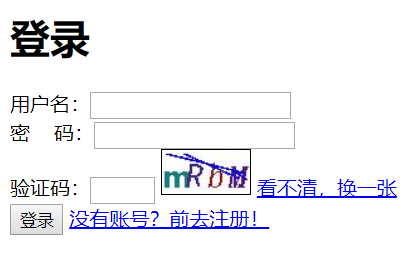Although java's graphics processing has always been a weak point, it does not prevent us from making some small things, such as our most common captcha image.
Small knowledge points used:
- A little awt knowledge is used, but it's very simple.
- Basic image io output, which belongs to basic knowledge.
- OutputStream,ImageIO,Random,BufferedImage
Here is the code to generate the verification code picture:
import java.awt.BasicStroke;
import java.awt.Color;
import java.awt.Font;
import java.awt.Graphics2D;
import java.awt.image.BufferedImage;
import java.io.IOException;
import java.io.OutputStream;
import java.util.Random;
import javax.imageio.ImageIO;
public class VerifyCode
{
private int w = 70;
private int h = 35;
private Random r = new Random();
private String[] fontNames = { "Song style", "Chinese script", "Blackbody", "Microsoft YaHei", "Regular script_GB2312" };
private String codes = "23456789abcdefghjkmnopqrstuvwxyzABCDEFGHJKMNPQRSTUVWXYZ";
private Color bgColor = new Color(255, 255, 255);
private String text;
public VerifyCode() {}
private Color randomColor() {
int red = r.nextInt(150);
int green = r.nextInt(150);
int blue = r.nextInt(150);
return new Color(red, green, blue);
}
private Font randomFont()
{
int index = r.nextInt(fontNames.length);
String fontName = fontNames[index];
int style = r.nextInt(4);
int size = r.nextInt(5) + 24;
return new Font(fontName, style, size);
}
private void drawLine(BufferedImage image)
{
int num = 3;
Graphics2D g2 = (Graphics2D)image.getGraphics();
for (int i = 0; i < num; i++) {
int x1 = r.nextInt(w);
int y1 = r.nextInt(h);
int x2 = r.nextInt(w);
int y2 = r.nextInt(h);
g2.setStroke(new BasicStroke(1.5F));
g2.setColor(Color.BLUE);
g2.drawLine(x1, y1, x2, y2);
}
}
private char randomChar()
{
int index = r.nextInt(codes.length());
return codes.charAt(index);
}
private BufferedImage createImage()
{
BufferedImage image = new BufferedImage(w, h, 1);
Graphics2D g2 = (Graphics2D)image.getGraphics();
g2.setColor(bgColor);
g2.fillRect(0, 0, w, h);
return image;
}
public BufferedImage getImage()
{
BufferedImage image = createImage();
Graphics2D g2 = (Graphics2D)image.getGraphics();
StringBuilder sb = new StringBuilder();
for (int i = 0; i < 4; i++) {
String s = randomChar() + "";
sb.append(s);
float x = i * 1.0F * w / 4.0F;
g2.setFont(randomFont());
g2.setColor(randomColor());
g2.drawString(s, x, h - 5);
}
text = sb.toString();
drawLine(image);
return image;
}
public String getText()
{
return text;
}
public static void output(BufferedImage image, OutputStream out)
throws IOException
{
ImageIO.write(image, "JPEG", out);
}
}
Here is an example of a login application scenario:
- First, we create a simple login interface:
<%@ page language="java" contentType="text/html; charset=UTF-8"
pageEncoding="UTF-8"%>
<%@taglib prefix="c" uri="http://java.sun.com/jsp/jstl/core" %>
<!DOCTYPE html>
<html>
<head>
<meta charset="UTF-8">
<title>Login page</title>
<link rel="icon" href="image/icon1.png" />
<script type="text/javascript">
function _change(){
//Get img element
var ele = document.getElementById("vCode");
ele.src= "<c:url value='/VerifyCodeServlet'/>?xxx=" + new Date().getTime();
}
</script>
</head>
<body>
<h1>Sign in</h1>
<p style="color: red; font-weight: 900">${msg }</p>
<form action="<c:url value="/LoginServlet"/>" method="post">
User name:<input type="text" name="username" value="${user.username }"/><br />
dense Code:<input type="password" name="password" value="${user.password }"/><br />
Verification Code:<input type="text" name="verifyCode" size="3"/>
<img id="vCode" src="<c:url value='/VerifyCodeServlet'/>" border="1"/>
<a href="javascript: _change()">I can't see clearly. Change it</a><br />
<input type="submit" value="Sign in"/>
<a href="regist.jsp">No account? Register!</a>
</form>
</body>
</html>
- Then we create a Servlet class named VerifyCodeServlet to call the dynamically generated code image:
@WebServlet("/VerifyCodeServlet")
public class VerifyCodeServlet extends HttpServlet {
protected void doGet(HttpServletRequest request, HttpServletResponse response) throws ServletException, IOException {
/*
* 1. Create verification code class
*/
VerifyCode vc = new VerifyCode();
/*
* 2. Get captcha picture
*/
BufferedImage image = vc.getImage();
/*
* 3. Save the text on the picture to the session
*/
request.getSession().setAttribute("session_vcode", vc.getText());
/*
* 4. Respond the picture to the client
*/
VerifyCode.output(image, response.getOutputStream());
}
}
In this way, we not only save the image to the response, but also save the generated content, which is used to verify the image content
Run the interface with tomcat:
This is the picture we generated:
At the same time, you can use the previously saved data to verify whether it is successful
Click Change and call the method repeatedly to refresh:
